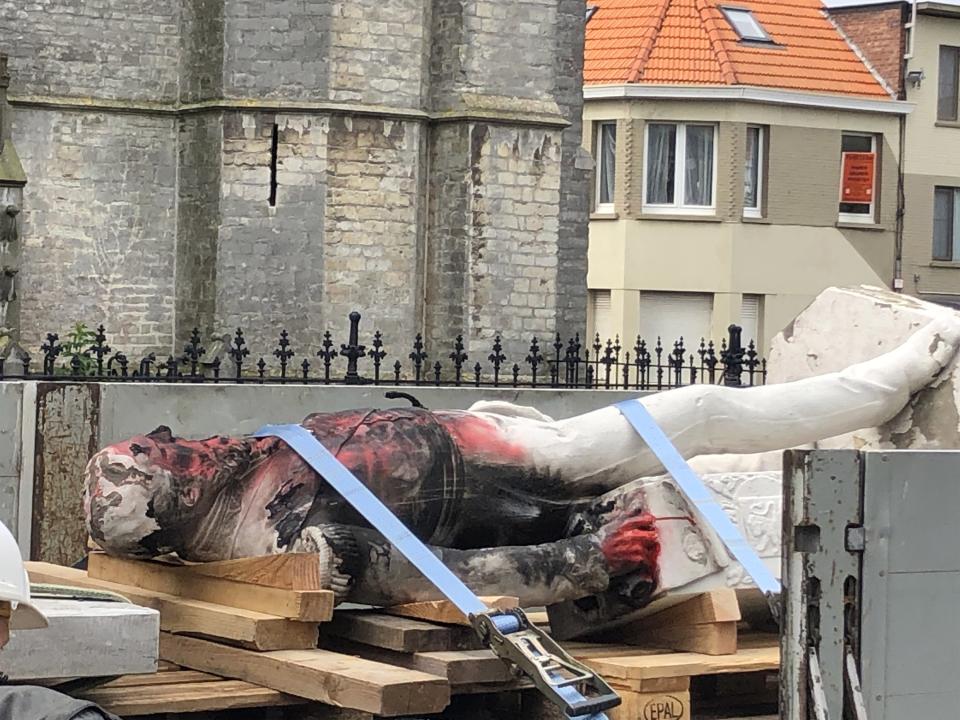About the statue
The statue is part of Antwerp’s cultural heritage and belongs to the municipal public art collection (Collectie Kunst in de Stad), which is managed, studied, and made publicly accessible through the Kunst in de Stad branch of the Middelheim Museum. The statue was made by sculptor Joseph Jacques Ducaju in 1873. It was unveiled that same year in Ekeren to commemorate a visit by Leopold II in 1869. It is considered to be the first statue of this monarch to be erected in Belgian public space. Its position on the Market Square in Ekeren has changed twice, in 1960 and 1993, whereby the original plinth was lost. In 2018 the Ekeren district administration added an information panel to explain the link between the statue and the colonial past.
You will find more details about the history of this statue in this illustrated timeline (pdf).
Leopold II and his rule over Congo Free State
Although Ducaju’s statue was installed in 1873, and Congo Free State was established – as the personal possession of Leopold II – in 1885, statues in his honour are generally viewed as symbols of Belgian colonial exploits in Congo. Already during the reign of Leopold II there were international political protests and local revolts against the exploitation and violence that characterised the regime in Congo Free State. Wars of conquest, repression, forced labour, starvation and epidemics cost the lives of innumerable Congolese. Although no official population registers were kept, research has shown that in the course of Leopold II’s ravaging regime, research shows that the size of the population decreased by between roughly 8 and 10 million people.
In light of this exploitation and extermination of the Congolese, statues of Leopold II can be considered to glorify or gloss over these facts. These statues thus put into sharp focus the question of which stories, people and events we commemorate in our shared public space?
The removal of the statue
The decision to remove the statue was made following sustained and escalating acts of vandalism. The first documented act of vandalism occurred in 2007, when red paint was poured over the statue, symbolising blood, and was followed by an identical occurrence in 2009. Between 16 May and 3 June 2020, three acts of vandalism took place, culminating in the statue being set on fire. On 4 June 2020 the mayor of Antwerp and the mayor of the district Ekeren decided to have the statue removed. On 9 June 2020 the plinth was dismantled and the statue was taken into storage at the Middelheim Museum. The information panel was taken into storage by the district council.
Kunst in de Stad (Art in the City) and the Middelheim Museum
The Middelheim Museum and Kunst in de Stad deem vandalism an ill-found basis for debate. At the same time, we recognise that previous and present acts of vandalism demonstrate that this and other statues are experienced as offensive, painful and undesirable. With increasing awareness of discrimination and racism, expanded historical knowledge and insights, and an extremely diverse and rapidly changing urban society, the way in which this sort of statue is seen today is a long way from the attitude that prevailed when they were first erected. After all, art in public space occupies a communal space and derives its meaning from people’s shared awareness of the intention behind it and how this message is received by the inhabitants of and visitors to the city. We think there is a need for debate on the shifting significance of such statues, employing the nuanced vocabulary of simultaneous or conflicting heritage values.
What now?
The statue has been taken to the storage that also houses other works from the Middelheim Museum collection and the Kunst in de Stad collection. The administrators of the Kunst in de Stad collection will investigate the current condition of the statue, taking as a guideline the conviction that the material state and the symbolic meaning of the work are one and indivisible.
They remain available to give additional clarification on the statue of Leopold II and, if so desired, on other monuments in public space, colonial or otherwise. This relates to art historical sculptures of varying heritage, social, and artistic value, and which thus all have specific requirements: it is neither possible nor desirable to take a ready-made approach to addressing questions about various colonial monuments. Ideally, dialogue and research provide the basis for a contemporary approach to this complex and contested heritage. There is no single template available; each concrete situation will have to be examined separately. Kunst in de Stad considers contemporary artists as essential conversation partners in this matter.
At any rate, we know that here in Antwerp we are not alone in dealing with these questions: “Societal debates on these delicate topics are currently taking place in all those European countries that had colonies overseas. (…) The first lesson for the present is that there is no point in ignoring these tough questions. They require an open mind. We have to provide context and begin a dialogue with each other.” (Source: Beladen Erfgoed, Feb. 2019, published by the Rijksdienst voor Cultureel Erfgoed, NL).
Heritage organisations, academics, civil organisations, artists, city councils: we must all talk to each other and examine how we can transform Antwerp into an ‘open history book’.



